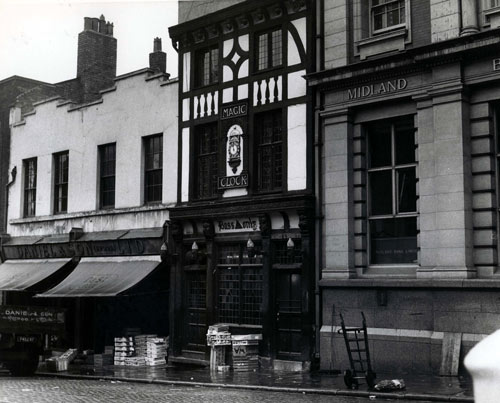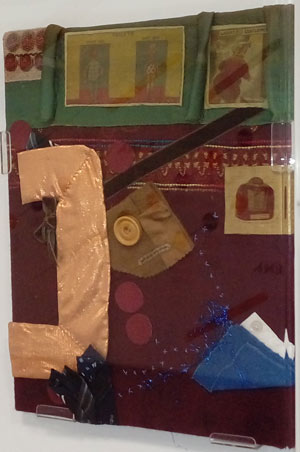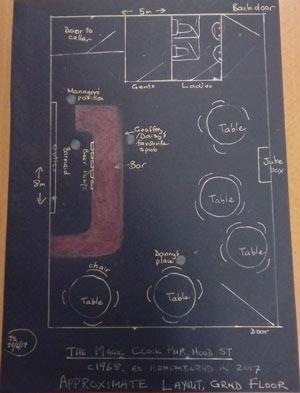
The Magic Clock, Roe Street, 1968. Courtesy of Liverpool Record Office, Liverpool Libraries.
Dr Jo Stanley, creative historian, made a textile artwork of the interior of the Magic Clock pub, Roe Street, Liverpool, especially for our
Tales from the city exhibition. Jo, originally from Crosby, was a barmaid at the pub, over Christmas 1968 and Easter 1969, in vacations from teacher training college.
The Magic Clock was popular with gay men. It was situated in Liverpool’s original ‘gay quarter’ around Queen Square.
Jo tells us more -
“In my time it wasn’t a rollicking camp sort of pub. Nor was it full of sailors or those who fancied them. It felt like a safe space but not iconic, poncey or pioneering.
My favourite customer was Daisy/ Geoffrey, a Bebington hairdresser who slightly cross-dressed. The other customer who stood out was a lunchtime guy called Johnny or Denny. He was an Irish building worker who flaunted his muscles, his gorgeous blue eyes alert for action. The clusters of businessmen ogled him.
Whether men went into the ladies or gents was their business. I got used to sharing mascara and hesitating about whether to say she or he. It made me very accepting of diversity.

Textile artwork of the interior of the Magic Clock, Jo Stanley, 2017
This textile art piece sums up the essence of the Magic Clock as I remember it. It's got the traditional pub furniture such as the red leather barstools and the jukebox. But it's also comprised of gritty taboo matter: gendered toilet use and the "smutty" jokes made about the huge significance of difference and of the possibilities of transgression. The green Victorian-tiled boundaries of the Ladies and Gents are crucial, but already subverted.The copper-topped bar dominates. It’s presided over by me, the barmaid with velvet ribbon in her hair and by the nearby manager, John Shergold, his back to the Bass kegs below. John is represented by the conventional tie. Its conservative maleness links to the three businessmen. The chaps are eyeing up Denny, the sparkly-eyed stud-like building worker who hangs about in pristine white shirt and sweaty denims, exuding readiness to give anyone lunchtime attention in return for money.
For me the key element in this artwork is the ugly gash of a buttonhole Daisy/Geoffrey made in his-her camel coat, because he wanted to dress as a ‘proper’ woman.
It isn’t beautiful but it is authentic. It's my subjective history of the Magic Clock, a space that many decades later I re-understand”.

Hand-drawn plan of the interior of the Magic Clock, Jo Stanley, 2017
Jo also drew this plan of the interior of the pub, which you can see on display in the exhibition adjacent to her artwork.
‘Re-texturing history’, making textile art with historical photos transferred to fabric is just one of Jo Stanley’s many research areas. “This seems to me to be a way of adding another dimension to history, especially using old clothes and photoshopped images”. For further information about Jo’s research and work please see
www.jostanley.biz
In the exhibition you can also watch a film, created by Hurricane Films, of Cloud Downey talking about his experiences of being gay in Liverpool during the 1950s and going to the Magic Clock.

 The Magic Clock, Roe Street, 1968. Courtesy of Liverpool Record Office, Liverpool Libraries.
Dr Jo Stanley, creative historian, made a textile artwork of the interior of the Magic Clock pub, Roe Street, Liverpool, especially for our Tales from the city exhibition. Jo, originally from Crosby, was a barmaid at the pub, over Christmas 1968 and Easter 1969, in vacations from teacher training college.
The Magic Clock was popular with gay men. It was situated in Liverpool’s original ‘gay quarter’ around Queen Square.
Jo tells us more -
The Magic Clock, Roe Street, 1968. Courtesy of Liverpool Record Office, Liverpool Libraries.
Dr Jo Stanley, creative historian, made a textile artwork of the interior of the Magic Clock pub, Roe Street, Liverpool, especially for our Tales from the city exhibition. Jo, originally from Crosby, was a barmaid at the pub, over Christmas 1968 and Easter 1969, in vacations from teacher training college.
The Magic Clock was popular with gay men. It was situated in Liverpool’s original ‘gay quarter’ around Queen Square.
Jo tells us more -
 Textile artwork of the interior of the Magic Clock, Jo Stanley, 2017
Textile artwork of the interior of the Magic Clock, Jo Stanley, 2017
 Hand-drawn plan of the interior of the Magic Clock, Jo Stanley, 2017
Jo also drew this plan of the interior of the pub, which you can see on display in the exhibition adjacent to her artwork.
‘Re-texturing history’, making textile art with historical photos transferred to fabric is just one of Jo Stanley’s many research areas. “This seems to me to be a way of adding another dimension to history, especially using old clothes and photoshopped images”. For further information about Jo’s research and work please see www.jostanley.biz
In the exhibition you can also watch a film, created by Hurricane Films, of Cloud Downey talking about his experiences of being gay in Liverpool during the 1950s and going to the Magic Clock.
Hand-drawn plan of the interior of the Magic Clock, Jo Stanley, 2017
Jo also drew this plan of the interior of the pub, which you can see on display in the exhibition adjacent to her artwork.
‘Re-texturing history’, making textile art with historical photos transferred to fabric is just one of Jo Stanley’s many research areas. “This seems to me to be a way of adding another dimension to history, especially using old clothes and photoshopped images”. For further information about Jo’s research and work please see www.jostanley.biz
In the exhibition you can also watch a film, created by Hurricane Films, of Cloud Downey talking about his experiences of being gay in Liverpool during the 1950s and going to the Magic Clock.
